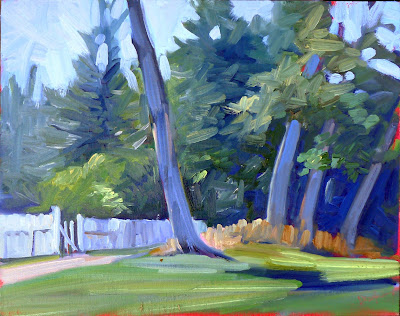Every line we paint, if we paint it honestly, tells the story of us and our feelings about the subject.
 |
| Sometimes it rains, by Carol L. Douglas, available through Ocean Park Association. |
My husband is a stylish bass player. He says that he seldom thinks about style; instead, it’s that space between what he is technically capable of playing and what he’s visualized. I recognize that the same thing is true in my own painting.
I never get into questions of style with my students. It’s ineffable. I once had a teacher who lauded the heavy lines in my painting. “It’s your style,” he said. Actually, I didn’t like it but I hadn’t learned to marry edges yet.
Jennifer Johnson rode up to Schoodic Institute with me yesterday; this is her fourth year at my Sea & Sky workshop. She’s learned to produce a competent painting in a reasonable amount of time. “But how do I put my own emotion, my own self, into my painting?” she asked me. I had to laugh. Her paintings are as lively and quirky as she is.
 |
| Tom Sawyer’s Fence, by Carol L. Douglas, available. |
No two artists paint the same scene the same way. Coincidentally, most of my plein air class on Tuesday chose the exact same long view to paint: a majestic vista down Clary Hill’s blueberry barrens. Each painting was markedly different.
Every line we paint, if we paint it honestly, tells the story of us and our feelings about the subject. Style is not something you add into a painting; it’s a reflection of your personality.
That doesn’t mean we shouldn’t paint deeper subjects. I don’t paint boats just because they’re beautiful, but because they’re meaningful symbols of the human journey. But the essential self-expression happens not in the content, but in the paintwork itself.
 |
| Blueberry barrens, Clary Hill, by Carol L. Douglas. Available through Maine Farmland Trust Gallery. |
I’ve noticed that artists—myself included—often want to obliterate the very things in our painting that are most honest and autobiographical. Our brushwork can feel crabbed to us even if other viewers see it as intense or lyrical. We want to make things that are smooth, refined, and loose even when we’re uproarious or unsettled.
Yet the painters we most admire are often the ones who were most self-revelatory. For every Van Gogh, Toulouse-Lautrec, Seurat, Pissarro, Monet, or Manet, there were hundreds of other painters hanging around Paris whom we don’t remember. They trotted out carefully produced, well-designed, even stylish canvases that have no ability to move us today.
Any decent critic can tell you what makes a good painting. It’s harder to identify what makes a great painting, but I think it must include big concepts: tragedy, sublimity, beauty, ugliness, joy, terror. A masterwork is of course a product of its time, but to transcend that, it must tell essential truths that transcend time and place.
 |
| Mountain fog, by Carol L. Douglas. Available. |
For those to be in your painting, they must be in you in the first place, and you have to be willing to be honest. I’ve learned to set aside paintings that irritate me and revisit them in the future; like Wildfire(which I wrote about here) they sometimes have the capacity to surprise me. This is why I discourage people from tossing ‘failed’ paintings too soon. Sometimes our conscious minds need time to catch up with our sympathetic intelligence.
None of this negates the importance of instruction, by the way. We all learned to write in cursive in the same way, but every person’s handwriting ends up so individualized that experts can determine when it’s forged.
I’m teaching my annual Sea & Sky workshop in Acadia National Park this week—two months later than its usual August date. After that, there’s Find Your Authentic Voice in Plein Air in Tallahassee, Florida, in early November, and a few more plein air classes in Rockport, ME. From there on in, it’s all Zoom, Zoom, Zoom until the snow stops flying.
